Consequences of Vatican II
 |
 |
 |
 |
 |
 |
 |
Amazonia Synod – Part I
Revolutionary Agenda of the Amazonia Synod
In October 2019, the Pan-Amazonia Synod will be held in Rome, bringing together Bishops and laity from nine countries whose territories include parts of this immense geographical region.
The Preparatory Document for this Synod – released June 8, 2019 – deals with the following points of interest:
These sources also stress that the meeting aims to achieve a "pastoral and ecological conversion" to this new pan-religiosity. In other words, the Conciliar Church intends to "sacralize" the "ecological liberation" of the Amazon by presenting it as a religious obligation. It is an old tactic of Liberation Theology, now being applied by the Pope and the Vatican.
Comments by Prof. Plinio Corrêa de Oliveira on ECO '92, or RIO '92, hosted by the United Nations in Rio de Janeiro on June 3-14, 1992, to discuss the environment and development, were published in the monthly magazine Catolicismo.
On that occasion, Prof. Plinio denounced the exaggerated concern for ecology as being a pretext to present false notions of justice and the rights of the people. That analysis today sheds a blazing light on the reality of the Synod on the Amazon that will be held in October 2019.
For this reason, we will comment on some excerpts from that analysis.
Eco '92: Appearance & deeper reality
Based on documents and supporting evidence, Prof Plinio distinguished two aspects at the ECO '92 Congress: appearance and reality,
In appearance, the message to the public was that the scientists concluded that the earth is seriously threatened by the brutal, anti-scientific, predatory abuses made against it by man. Therefore, all governments must pass legislation to ensure that the earth can continue to be used by men: It is a life or death situation.
However, to understand what really happened in ECO '92 – the deeper reality – other important aspects must be taken into account.
An ecumenical & universal Tribalism
Addressing an emerging tribalism, Prof. Plinio stated: "There is a current of thinkers who affirm that it is necessary for the Indian to be taken as the model for human behavior. It is understood that civilization depredates the earth and that the tribe is the ideal toward which man must walk.
"This current goes further and asserts that reasoning is a flawed instrument to know the truth. Therefore, we must discard science and progress because they are based on reasoning. It is also necessary to do away with Theology, since it is the application of the intelligence to the data of Revelation. Therefore, no Church, no Theology, no State. Everything must be loose, ungoverned and uncoordinated, following the ways of the Indians." (Catolicismo, n. 501, September 1992)
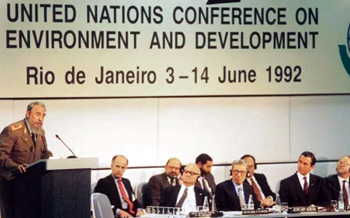
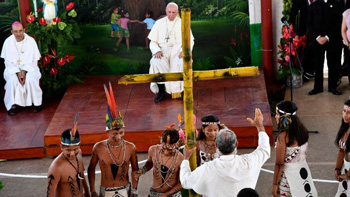 At the meeting, the UN presented itself as the world super-authority: "This meeting of heads of State was a first step towards the constitution of a global ecological authority, under which all nations would disappear to form a single universal magma."
At the meeting, the UN presented itself as the world super-authority: "This meeting of heads of State was a first step towards the constitution of a global ecological authority, under which all nations would disappear to form a single universal magma."
ECO '92 was also symbolic in another respect: "The general view expressed at the NGO meetings was that all religions are the same. To be Catholic, Buddhist, Brahmanist, a sun worshiper – everything is the same thing. It is the most radical ecumenism, condemned many times by the Holy See. "(ibid)
In summary: "The Revolution wanted to overthrow ecclesiastical authority by means of Protestantism; temporal authority through the French Revolution; and economic and social inequalities through Communism. Now, all these attempts come together: Doesn't this pantheistic attitude, which demands that man serve the earth, transform the king into the lackey's footman?" (ibid)
These were the general lines of RIO '92, which fit like a glove to the goals of the Amazonia Synod. There is, however, a fundamental difference. In 1992 the propelling revolutionary forces were the UN and the NGOs. Today, these organizations have lost much of their prestige. So, we are seeing the Catholic Church, or rather the Conciliar Church – defined as the Catholic Church as usurped by Progressivism – driving the Revolution.
In addition to promoting tribalism and ecumenism and encouraging a global ecological authority, the Conciliar Church seems to want to use the next Synod to destroy priestly celibacy and establish the female priesthood.
‘Nothing will be the same in the Church after the Amazon Synod’
Bishop Franz-Josef Overbeck, the pro-LGBT Bishop of the German Diocese of Essen, has predicted that the October Synod will cause a "rupture" in the Church and that "nothing will be as it was before," according to Katholische.de, official website of the German Bishops.
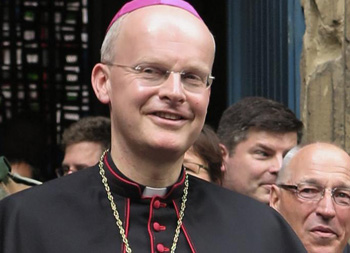 He stated that the hierarchical structure of the Church, its sexual morality, and the general picture of the priesthood would be thoroughly scrutinized and that the role of women in the Church would also be reconsidered.
He stated that the hierarchical structure of the Church, its sexual morality, and the general picture of the priesthood would be thoroughly scrutinized and that the role of women in the Church would also be reconsidered.
Overbeck reported that the decline in the number of the Catholic faithful in Europe and Latin America would be on the agenda, along with the topic of the "immense exploitation" of the environment and the violations of human rights.
The Synod will take place from October 6 to 27 and among its main themes are ecology, theology and pastoral care, the concerns of indigenous peoples and human rights.
Overbeck praised Francis who, with his South American perspective, guarantees keen "awareness of these challenges." The "Eurocentric structure" of the Church, he emphasized, "is about to be extinguished."
"The face of the local church is feminine," he added.
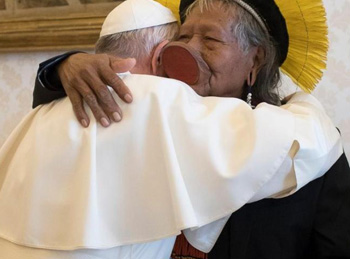 The statistics cited by the German Bishop are quite expressive of the decreased influence of the Catholic Church in countries like Brazil: Catholics, who used to make up 90% of the population, now total only 70%. The Prelate said that the Church must address this situation and seek answers.
The statistics cited by the German Bishop are quite expressive of the decreased influence of the Catholic Church in countries like Brazil: Catholics, who used to make up 90% of the population, now total only 70%. The Prelate said that the Church must address this situation and seek answers.
So then, what will come from this Synod? Speculations speak of a tremendous change in the doctrine of the Church, the celibacy of priests, and even in the manner of the consecration of bread and wine at the Holy Mass.
The aim of this supposedly "missionary" Synod seems to be to establish a new egalitarian global order in human society.
Continued

The Preparatory Document for this Synod – released June 8, 2019 – deals with the following points of interest:
- New pathways for the Church and an integral ecology;
- A "deep crisis" triggered by prolonged human interference in the Amazon jungle, a matter of "vital importance for the planet Earth";
- The "vital importance" for the universal Church to listen to the indigenous peoples and communities living in the Amazon;
- New paths for an evangelization that will shape "a Church with an Amazonian face," which will emerge from a "culture of the encounter" in daily life, "a multifarious harmony" and "happy sobriety."
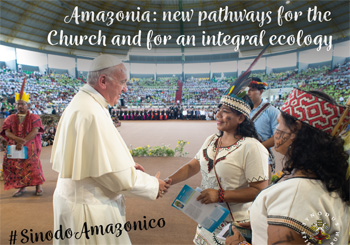
The Synod logo and theme: New pathways for the Church and for an integral ecology
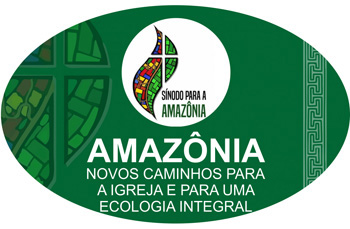
These sources also stress that the meeting aims to achieve a "pastoral and ecological conversion" to this new pan-religiosity. In other words, the Conciliar Church intends to "sacralize" the "ecological liberation" of the Amazon by presenting it as a religious obligation. It is an old tactic of Liberation Theology, now being applied by the Pope and the Vatican.
Comments by Prof. Plinio Corrêa de Oliveira on ECO '92, or RIO '92, hosted by the United Nations in Rio de Janeiro on June 3-14, 1992, to discuss the environment and development, were published in the monthly magazine Catolicismo.
On that occasion, Prof. Plinio denounced the exaggerated concern for ecology as being a pretext to present false notions of justice and the rights of the people. That analysis today sheds a blazing light on the reality of the Synod on the Amazon that will be held in October 2019.
For this reason, we will comment on some excerpts from that analysis.
Eco '92: Appearance & deeper reality
Based on documents and supporting evidence, Prof Plinio distinguished two aspects at the ECO '92 Congress: appearance and reality,
In appearance, the message to the public was that the scientists concluded that the earth is seriously threatened by the brutal, anti-scientific, predatory abuses made against it by man. Therefore, all governments must pass legislation to ensure that the earth can continue to be used by men: It is a life or death situation.
However, to understand what really happened in ECO '92 – the deeper reality – other important aspects must be taken into account.
An ecumenical & universal Tribalism
Addressing an emerging tribalism, Prof. Plinio stated: "There is a current of thinkers who affirm that it is necessary for the Indian to be taken as the model for human behavior. It is understood that civilization depredates the earth and that the tribe is the ideal toward which man must walk.
"This current goes further and asserts that reasoning is a flawed instrument to know the truth. Therefore, we must discard science and progress because they are based on reasoning. It is also necessary to do away with Theology, since it is the application of the intelligence to the data of Revelation. Therefore, no Church, no Theology, no State. Everything must be loose, ungoverned and uncoordinated, following the ways of the Indians." (Catolicismo, n. 501, September 1992)

At Eco 92, The UN took the role of leader; today's Synod shifts the role to the Pope & Conciliar Church

ECO '92 was also symbolic in another respect: "The general view expressed at the NGO meetings was that all religions are the same. To be Catholic, Buddhist, Brahmanist, a sun worshiper – everything is the same thing. It is the most radical ecumenism, condemned many times by the Holy See. "(ibid)
In summary: "The Revolution wanted to overthrow ecclesiastical authority by means of Protestantism; temporal authority through the French Revolution; and economic and social inequalities through Communism. Now, all these attempts come together: Doesn't this pantheistic attitude, which demands that man serve the earth, transform the king into the lackey's footman?" (ibid)
These were the general lines of RIO '92, which fit like a glove to the goals of the Amazonia Synod. There is, however, a fundamental difference. In 1992 the propelling revolutionary forces were the UN and the NGOs. Today, these organizations have lost much of their prestige. So, we are seeing the Catholic Church, or rather the Conciliar Church – defined as the Catholic Church as usurped by Progressivism – driving the Revolution.
In addition to promoting tribalism and ecumenism and encouraging a global ecological authority, the Conciliar Church seems to want to use the next Synod to destroy priestly celibacy and establish the female priesthood.
‘Nothing will be the same in the Church after the Amazon Synod’
Bishop Franz-Josef Overbeck, the pro-LGBT Bishop of the German Diocese of Essen, has predicted that the October Synod will cause a "rupture" in the Church and that "nothing will be as it was before," according to Katholische.de, official website of the German Bishops.

Bishop Overbeck proclaims nothing will remain the same after the Synod
Overbeck reported that the decline in the number of the Catholic faithful in Europe and Latin America would be on the agenda, along with the topic of the "immense exploitation" of the environment and the violations of human rights.
The Synod will take place from October 6 to 27 and among its main themes are ecology, theology and pastoral care, the concerns of indigenous peoples and human rights.
Overbeck praised Francis who, with his South American perspective, guarantees keen "awareness of these challenges." The "Eurocentric structure" of the Church, he emphasized, "is about to be extinguished."
"The face of the local church is feminine," he added.

New face of the Church: The Pope embraces self-disfigured Brazilian tribal chief Raoni
So then, what will come from this Synod? Speculations speak of a tremendous change in the doctrine of the Church, the celibacy of priests, and even in the manner of the consecration of bread and wine at the Holy Mass.
The aim of this supposedly "missionary" Synod seems to be to establish a new egalitarian global order in human society.
Continued

Posted June 28, 2019
______________________
______________________
 Volume I |
 Volume II |
 Volume III |
 Volume IV |
 Volume V |
 Volume VI |
 Volume VII |
 Volume VIII |
 Volume IX |
 Volume X |
 Volume XI |
 Special Edition |


